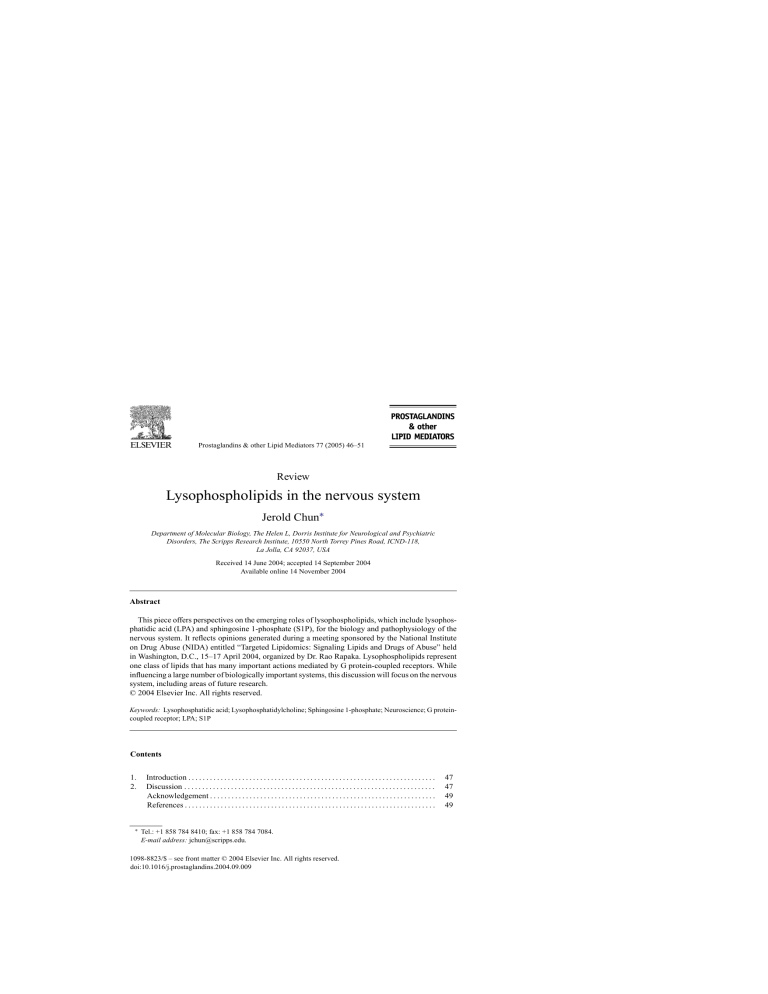Lysophospholipids in the nervous system Jerold Chun Review ∗

Prostaglandins & other Lipid Mediators 77 (2005) 46–51
Review
Lysophospholipids in the nervous system
Jerold Chun
Department of Molecular Biology, The Helen L, Dorris Institute for Neurological and Psychiatric
Disorders, The Scripps Research Institute, 10550 North Torrey Pines Road, ICND-118,
La Jolla, CA 92037, USA
Received 14 June 2004; accepted 14 September 2004
Available online 14 November 2004
Abstract
This piece offers perspectives on the emerging roles of lysophospholipids, which include lysophosphatidic acid (LPA) and sphingosine 1-phosphate (S1P), for the biology and pathophysiology of the nervous system. It reflects opinions generated during a meeting sponsored by the National Institute on Drug Abuse (NIDA) entitled “Targeted Lipidomics: Signaling Lipids and Drugs of Abuse” held in Washington, D.C., 15–17 April 2004, organized by Dr. Rao Rapaka. Lysophospholipids represent one class of lipids that has many important actions mediated by G protein-coupled receptors. While influencing a large number of biologically important systems, this discussion will focus on the nervous system, including areas of future research.
© 2004 Elsevier Inc. All rights reserved.
Keywords: Lysophosphatidic acid; Lysophosphatidylcholine; Sphingosine 1-phosphate; Neuroscience; G proteincoupled receptor; LPA; S1P
Contents
1.
Introduction . . . . . . . . . . . . . . . . . . . . . . . . . . . . . . . . . . . . . . . . . . . . . . . . . . . . . . . . . . . . . . . . . . . . .
47
2.
Discussion . . . . . . . . . . . . . . . . . . . . . . . . . . . . . . . . . . . . . . . . . . . . . . . . . . . . . . . . . . . . . . . . . . . . . .
47
Acknowledgement . . . . . . . . . . . . . . . . . . . . . . . . . . . . . . . . . . . . . . . . . . . . . . . . . . . . . . . . . . . . . . .
49
References . . . . . . . . . . . . . . . . . . . . . . . . . . . . . . . . . . . . . . . . . . . . . . . . . . . . . . . . . . . . . . . . . . . . . .
49
∗
Tel.: +1 858 784 8410; fax: +1 858 784 7084.
E-mail address: jchun@scripps.edu.
1098-8823/$ – see front matter © 2004 Elsevier Inc. All rights reserved.
doi:10.1016/j.prostaglandins.2004.09.009
J. Chun / Prostaglandins & other Lipid Mediators 77 (2005) 46–51 47
1. Introduction
Lysophospholipids are small lipid molecules that have been shown, in recent years, to have a range of important effects on many different organ systems. The best studied examples of lysophospholipids are lysophosphatidic acid (LPA) and sphingosine 1phosphate (S1P), which are part of a host of related molecules that are defined by a 3-carbon backbone, glycerol or sphingoid in nature, to which an acyl chain having variable length and saturation is attached. A major focus in recent years has been the action of extracellular lysophospholipids through their cognate G protein coupled receptors (GPCRs): there are nine lysophospholipids receptors, 4 for LPA (LPA
1–4
) and 5 for
S1P (S1P
1–5
), with a number of putative lysophospholipid GPCRs existing in the literature. Recent reviews have covered many facets of this rapidly growing field in detail
[1–17] and no attempt will be made to review this extensive literature. The purpose of this
opinion piece is to stimulate discussion and increase awareness of areas relevant to Neuroscience, towards achieving an understanding of both the basic neurobiology of lysophospholipid signaling, and a framework for therapeutically useful strategies involving activated pathways.
2. Discussion
An essential distinction that must be made in assessing effects produced by lysophospholipids is whether their effects involve surface receptors – GPCRs – or non-GPCR mechanisms that could utilize different pathways, such as seen with S1P intracellular functions in Arabidopsis
[18] . The necessity for this distinction, particularly in the nervous system
where there exists enormous complexity of cellular interactions, is differentiating true signaling properties of lysophospholipids from important but non-signaling roles that include pools associated with lipid metabolism, and structural pools that contribute to non-signaling roles such as the effects of LPA on synaptic vesicle curvature
not place a value judgment on the importance of signaling versus non-signaling roles. It does underscore the experimental tractability of rigorously distinguishing direct effects of lysophospholipids attributable to the nine identified GPCRs, which contrasts with attributing neural effects to non-GPCR mechanisms. The existence of numerous orphan GPCRs amongst the 350–400 non-olfactory/sensory GPCRs in mouse and human
clear possibility that the currently known repertoire of lysophospholipid GPCRs
is incomplete, a point underscored by non-homologous GPCRs for single lysophospholipid ligands, as has been reported for LPA
[21] . Therefore, at least within the mammalian
nervous system, biological actions of lysophospholipids should first be considered for their potential GCPR-mediated mechanisms before invoking non-GPCR or non-receptor mechanisms.
Related to this view is the existence of genetic deletions in mice for most known lysophospholipid receptors
[22,23,17] and the advent of chemical tools that show receptor agonist
and antagonist properties (reviewed in
[17] ). Combined use of these experimental reagents
can allow identification of essential roles for lysophospholipid GPCRs as well as roles for a given receptor subtype. It is notable that lysophospholipid receptors have apparent
48 J. Chun / Prostaglandins & other Lipid Mediators 77 (2005) 46–51
K d values with their cognate ligands in the nanomolar range, and thus nervous system effects observed in the micromolar range or higher must be interpreted with caution, particularly in differentiating those effects that are specific as compared to non-specific or toxic effects.
Considering these caveats, there is an enlarging range of neurobiologically relevant, receptor-mediated functions that portend the existence of more actions of lysophospholipid signaling. Much of what has thus far been identified has come from studies of neuralderived cell lines or the developing mammalian nervous system, including isolation of primary cells from many developmental ages preceding adulthood. Most of these types of studies have involved analyses of cells in culture or in tissue sections. Examples of observed effects include neuroprogenitor cell influences in the cerebral cortex such as cell morphology, cell survival, cell cycle progression, cell migration, electrophysiological changes and growth cone guidance, along with a large range of activated, downstream signaling molecules. Other effects have been observed in glia – both in situ and in culture – that affect Schwann cells, oligodendrocytes, astrocytes and microglia, producing alterations in cell morphology and cell adhesion, as well as signaling pathway activation.
Most of these effects appear to be cell intrinsic, whereby receptor activation of individual receptors through exogenous lipids results in a cellular change within the activated cell.
In addition to cell intrinsic responses, systemic effects on larger populations of neural cells have also been observed, producing changes observed in both neuroanatomy and animal behavior. For example, LPA exposure can produce dramatic receptor-dependent changes on folding in the developing cerebral cortex, along with increases in cell number amongst both proliferating and postmitotic cells
[24] . Deletion of a single LPA receptor
(LPA
1
) produces olfactory deficits that may be centrally mediated
central defects, a behavioral phenotype reminiscent of Schizophrenia – as judged by prepulse inhibition studies – has also been reported
[26] . Alterations in neuronal excitability,
as judged by increased spontaneous seizure activity has also been reported in null mutants for an S1P receptor subtype (S1P
2
)
[27] . In addition to these results, roles for LPA receptor
subtypes in the initiation of neuropathic pain (LPA
1
) has recently been reported
studies and others have been reviewed
This broad range of activities underscores some of the possible areas that may emerge from continued study of lysophospholipids in the nervous system. Further studies on the developmental consequences of lysophospholipid receptor activation or absence will undoubtedly yield new insights into responses of various neural cell types or subtypes, including those not previously examined for lysophospholipid signaling. It is also notable that receptors within a ligand class (e.g. LPA receptors), as well as between classes (e.g.,
LPA versus S1P), show distinct expression patterns. This indicates that responses to lipid signals are controlled, at least in part, by receptor expression. A single cell type may express multiple receptor subtypes for a single ligand, as well as different receptor types for more than one lysophospholipid. Thus, a single ligand can produce different effects on one cell type, different lysophospholipid ligands can produce similar effects, and these represent non-mutually exclusive possibilities. Moreover, there exists the further possibility for both positive and negative cooperativity or synergism at the level of both receptors and ligands. This type of combinatorial interaction extends beyond lipids to interactions
J. Chun / Prostaglandins & other Lipid Mediators 77 (2005) 46–51 49 with protein receptors, as shown for the platelet-derived growth factor receptor (PDGFR)
[34–36] . It seems likely that other lipid receptor interactions in combination with other pep-
tide growth factor receptor tyrosine kinase receptors will have relevance to understanding neurobiological actions of lysophospholipids. Added to these possible cooperative interactions, it is likely that more lysophosopholipid GPCRs will be identified, adding further to receptor-based mechanisms in accounting for lysophospholipid actions within the nervous system.
Another area of interest could be in the neuroimmune axis, as lysophospholipid receptors are also expressed on a range of immunological cell types. This could have direct relevance to diseases in which a neuroimmune mechanism might be influenced or disrupted by lysophospholipid signaling. Indeed, this type of activity has been observed in mouse models of multiple sclerosis using agonists for S1P receptors
[37,38] . It is notable that lipid
involvement in these types of diseases may extend beyond lysophospholipids, based on the efficacy of cholesterol lowering drugs – statins – in multiple sclerosis mouse models
The relevance to human multiple sclerosis remains to be determined, however there is a way forward in this area in view of the entrance of at least one S1P receptor agonist into humans
A third general area of involvement may be that of cognitive function. Could more complex behavioral phenotypes have mechanistic explanations through lysophospholipid signaling? The phenotype of the LPA
1
–null mouse in which normal prepulse inhibition appeared disrupted suggests that lysophospholipid signaling mechanisms could be relevant. In this regard, it is notable that the nearest evolutionary neighbor to most lysophospholipid receptors are the cannabinoid receptors, CB1 and CB2. Not only do these receptors mediate the effects of delta-9 tetra-hydrocannabinol (THC the active ingredient of marijuana) but they also interact with the molecules 2-arachidonyl glycerol and anandamide, both of which have structural similarity to lysophospholipids. It may therefore be of interest to examine the behavioral consequences of deleting or otherwise altering normal lysophospholipid receptor function. The involvement of LPA signaling in prepulse inhibition may be related to observations on the role of the same LPA
1 receptor in the initiation of neuropathic pain since this injury model appears to involve a demyelination step
[28] . This is potentially relevant to a Schizophrenia-like
phenotype in view of myelin dysregulation reported for some cases of human Schizophrenia
[41,42] . Determining lysophospholipid signaling links between this disease and other neu-
rological or psychiatric diseases will be an active and likely fruitful area of future research.
Acknowledgement
This work was supported by the NIMH.
References
[1] Fukushima N, Ishii I, Contos JJ, Weiner JA, Chun J. Lysophospholipid receptors. Annu Rev Pharmacol
Toxicol 2001;41:507–34.
[2] Hla T. Sphingosine 1-phosphate receptors. Prostaglandins 2001;64:135–42.
50 J. Chun / Prostaglandins & other Lipid Mediators 77 (2005) 46–51
[3] Hla T, Lee MJ, Ancellin N, Paik JH, Kluk MJ. Lysophospholipids-receptor revelations. Science
2001;294:1875–8.
[4] Yatomi Y, Ozaki Y, Ohmori T, Igarashi Y. Sphingosine 1-phosphate: synthesis and release. Prostaglandins
2001;64:107–22.
[5] Kluk MJ, Hla T. Signaling of sphingosine-1-phosphate via the s1p/edg-family of g-protein-coupled receptors.
Biochim Biophys Acta 2002;1582:72–80.
[6] Meyer zu Heringdorf D, Himmel HM, Jakobs KH. Sphingosylphosphorylcholine-biological functions and mechanisms of action. Biochim Biophys Acta 2002;1582:178–89.
[7] Okajima F. Plasma lipoproteins behave as carriers of extracellular sphingosine 1-phosphate: is this an atherogenic mediator or an anti-atherogenic mediator? Biochim Biophys Acta 2002;1582:132–7.
[8] Siehler S, Manning DR. Pathways of transduction engaged by sphingosine 1-phosphate through g proteincoupled receptors. Biochim Biophys Acta 2002;1582:94–9.
[9] Spiegel S, Milstien S. Sphingosine 1-phosphate, a key cell signaling molecule. J Biol Chem
2002;277:25851–4.
[10] Takuwa Y, Takuwa N, Sugimoto N. The edg family g protein-coupled receptors for lysophospholipids: their signaling properties and biological activities. J Biochem (Tokyo) 2002;131:767–71.
[11] Xie Y, Gibbs TC, Meier KE. Lysophosphatidic acid as an autocrine and paracrine mediator. Biochim Biophys
Acta 2002;1582:270–81.
[12] Hla T. Signaling and biological actions of sphingosine 1-phosphate. Pharmacol Res 2003;47:401–7.
[13] Mills GB, Moolenaar WH. The emerging role of lysophosphatidic acid in cancer. Nat Rev Cancer
2003;3:582–91.
[14] Osborne N, Stainier DY. Lipid receptors in cardiovascular development. Annu Rev Physiol 2003;65:23–43.
[15] Spiegel S, Milstien S. Sphingosine-1-phosphate: an enigmatic signalling lipid. Nat Rev Mol Cell Biol
2003;4:397–407.
[16] Anliker B, Chun J. Lysophospholipid g protein-coupled receptors. J Biol Chem 2004;279:20555–8.
[17] Ishii I, Fukushima N, Ye X, Chun J. Lysophospholipid receptors: signaling and biology. Ann Rev Biochem
2004:73.
[18] Coursol S, Fan LM, Le Stunff H, Spiegel S, Gilroy S, Assmann SM. Sphingolipid signalling in arabidopsis guard cells involves heterotrimeric g proteins. Nature 2003;423:651–4.
[19] Schmidt A, Wolde M, Thiele C, et al. Endophilin i mediates synaptic vesicle formation by transfer of arachidonate to lysophosphatidic acid. Nature 1999;401:133–41.
[20] Vassilatis DK, Hohmann JG, Zeng H, et al. The g protein-coupled receptor repertoires of human and mouse.
Proc Natl Acad Sci USA 2003;100:4903–8.
[21] Noguchi K, Ishii S, Shimizu T. Identification of p2y9/gpr23 as a novel g protein-coupled receptor for lysophosphatidic acid, structurally distant from the edg family. J Biol Chem 2003;278:25600–6.
[22] Liu Y, Wada R, Yamashita T, et al. Edg-1, the g protein-coupled receptor for sphingosine-1-phosphate, is essential for vascular maturation. J Clin Invest 2000;106:951–61.
[23] Yang AH, Ishii I, Chun J. In vivo roles of lysophospholipid receptors revealed by gene targeting studies in mice. Biochim Biophys Acta 2002;1582:197–203.
[24] Kingsbury MA, Rehen SK, Contos JJ, Higgins CM, Chun J. Non-proliferative effects of lysophosphatidic acid enhance cortical growth and folding. Nat Neurosci 2003;6:1292–9.
[25] Contos JJ, Fukushima N, Weiner JA, Kaushal D, Chun J. Requirement for the lpa1 lysophosphatidic acid receptor gene in normal suckling behavior. Proc Natl Acad Sci USA 2000;97:13384–9.
[26] Harrison SM, Reavill C, Brown G, et al. Lpa1 receptor-deficient mice have phenotypic changes observed in psychiatric disease. Mol Cell Neurosci 2003;24:1170–9.
[27] MacLennan AJ, Carney PR, Zhu WJ, et al. An essential role for the h218/agr16/edg-5/lp(b2) sphingosine
1-phosphate receptor in neuronal excitability. Eur J Neurosci 2001;14:203–9.
[28] Inoue M, Rashid H, Fujita R, Contos JJA, Chun J, Ueda H. Initiation of neuropathic pain requires lysophosphatidic acid receptor signaling. Nat Med 2004;10:712–8.
[29] Chun J, Weiner JA, Fukushima N, et al. Neurobiology of receptor-mediated lysophospholipid signalling.
From the first lysophospholipid receptor to roles in nervous system function and development. Ann NY Acad
Sci 2000;905:110–7.
[30] Fukushima N, Chun J. The lpa receptors. Prostaglandins Other Lipid Mediat 2001;64:21–32.
J. Chun / Prostaglandins & other Lipid Mediators 77 (2005) 46–51 51
[31] Fukushima N, Ishii I, Contos JJ, Weiner JA, Chun J. Lysophospholipid receptors. Annu Rev Pharmacol
Toxicol 2001;41:507–34.
[32] Fukushima N, Ye X, Chun J. Neurobiology of lysophosphatidic acid signaling. Neuroscientist 2002;8:540–50.
[33] Ye X, Fukushima N, Kingsbury MA, Chun J. Lysophosphatidic acid in neural signaling. Neuroreport
2002;13:2169–75.
[34] Inoue CN, Ko YH, Guggino WB, Forster HG, Epstein M. Lysophosphatidic acid and platelet-derived growth factor synergistically stimulate growth of cultured rat mesangial cells. Proc Soc Exp Biol Med
1997;216:370–9.
[35] Herrlich A, Daub H, Knebel A, et al. Ligand-independent activation of platelet-derived growth factor receptor is a necessary intermediate in lysophosphatidic, acid-stimulated mitogenic activity in l cells. Proc Natl Acad
Sci USA 1998;95:8985–90.
[36] Rui L, Archer SF, Argetsinger LS, Carter-Su C. Platelet-derived growth factor and lysophosphatidic acid inhibit growth hormone binding and signaling via a protein kinase c-dependent pathway. J Biol Chem
2000;275:2885–92.
[37] Brinkmann V, Davis MD, Heise CE, et al. The immune modulator fty720 targets sphingosine 1-phosphate receptors. J Biol Chem 2002;277:21453–7.
[38] Webb M, Tham C-S, Lin F-F, et al. Sphingosine 1-phosphate receptor agonists attenuate relapsing-remitting experimental autoimmune encephalitis in sjl mice. J Neuroimmunol 2004;153:108–21.
[39] Stuve O, Youssef S, Steinman L, Zamvil SS. Statins as potential therapeutic agents in neuroinflammatory disorders. Curr Opin Neurol 2003;16:393–401.
[40] Rosen H, Liao J. Sphingosine 1-phosphate pathway therapeutics: A lipid ligand-receptor paradigm. Curr
Opin Chem Biol 2003;7:461–8.
[41] Hakak Y, Walker JR, Li C, et al. Genome-wide expression analysis reveals dysregulation of myelinationrelated genes in chronic schizophrenia. Proc Natl Acad Sci USA 2001;98:4746–51.
[42] Corfas G, Roy K, Buxbaum JD. Neuregulin 1-erbb signaling and the molecular/cellular basis of schizophrenia.
Nat Neurosci 2004;7:575–80.





